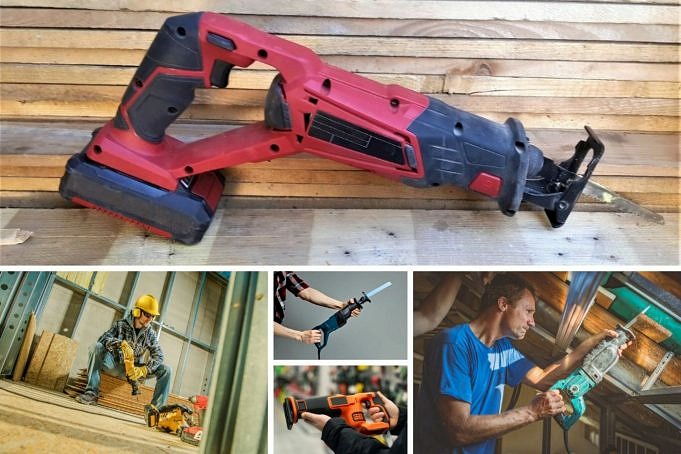A reciprocating saw is a common tool for DIYers. This saw is extremely versatile and can be used to complete a wide range of projects. It can be hard to cut precise lines if the blade gets clogged up or is covered with grime. This blog will show you how to remove grime from your reciprocating saw quickly and effectively. Have fun and be safe with your next project.
What You Will Need
1. Mixture of gritty water and solution
2. One pair of rubber gloves for you, and one old pair to rinse your blade.
3. A paper towel or rag
4. A toothbrush
5. To wash your saw in, a bucket or faucet
6. A drying and polishing cloth
7. WD-40 (optional)
8. Safety goggles are optional, but highly recommended for those who wear glasses.
How to Clean Grime off a Reciprocating Saw
1. To begin, fill a bucket with water. Next, add our gritty water solution that is made up of dishwashing detergent and an abrasive such as baking soda or coarse salt. (Just pick one!). This will break down the grime from your blade.
2. To prevent the rubber gloves from slipping while you wash the blade, put on your rubber gloves. Use a scraper, a toothbrush or an old rag to clean the blade.
3. To get rid of all the dirt and grime, rinse your blade under cold running water. If you don’t have a bucket, you can use a paper towel to scrape. You can give stubborn areas another round of soapy water if they remain.
4. Now it’s time to polish and dry! To remove any excess moisture, dry the saw blade with a paper towel or drying cloth. Then polish it off with WD-40 (optional). For an extra shine, you can give the saw blade a final wipe-down with a waterless cloth.
5. Voila! Voila! You now have a shiny, clean blade ready for your next project. This might help you avoid cutting yourself if you are lucky.
Exterior Cleaning
1. Before handling the blade of your reciprocating saw, put on rubber gloves
2. To dissolve the grime on the blade, soak it in warm water with dishwashing detergent and an abrasive agent such as baking soda or coarse salt.
3. Use a scraper or an old rag to remove grime. Wash off with running water.
4. Before polishing the exterior of your saw with WD-40, dry the blade with a clean cloth.
Interior Cleaning
1. Before handling the blade of your reciprocating saws, wear rubber gloves
2. To clean the finer details, soak the interior of your tool in a cleaning solution with a toothbrush.
3. Before reassembling, rinse the interior with water. Dry thoroughly with a rag.
How to Remove Rust from a Reciprocating Saw Blade.
Working with any type of metal item will always result in rust. Here are some easy steps to remove rust from your reciprocating saw blade if you’re unfortunate enough to have it.
1. You can place the blade in a bag with apple cider vinegar or white vinegar overnight, or for several hours until the rust has softened.
2. To remove the rusty spots, use a toothbrush. Next, wash your blade with soapy warm water and dry it with a towel or cloth.
What Are the Best Tips to Clean Grime from a Reciprocating Saw.
Safety first! Safety first! Be aware of what you are cutting and any objects in the way. You don’t want them to get caught in your blade. If these blades get stuck on anything, they can cause serious damage. Safety first!
Your saw blade will stay sharper if your work area is clean. You should remove any metal scraps or other debris that could cause injury to others and damage your tools.
It’s a good idea, after taking a break from your reciprocating saw, to apply some WD-40 on a cloth and clean the exterior of your saw. This will help prevent rust!
A toothbrush is an essential tool when working with power tools, especially if you are dealing with unusual shapes or sizes of materials.
How can I clean the grime off of my reciprocating saw?
There are several ways to remove rust from your reciprocating saw. For heavy-duty cleaning, you can mix baking soda, salt and vegetable oil in a bucket.
To get in the crevices and cracks you wouldn’t normally be able to reach, you could make a paste of vegetable oil and baking soda. Let everything sit for at least one night before washing it with warm water.
What’s Reciprocating Saw Blade Materials?
The blades of your reciprocating saw need to be made of tough material that can withstand the heat when cutting through metals such as steel and aluminum. High-speed steel (HSS) is a great choice. It is made of tough alloys and can withstand high pressure.
How long does a reciprocating saw blade last?
The blades of reciprocating saws are typically only good for about four hours. This means that you should always have spare blades on hand to use your power tools. After every use, you can lubricate your blade with an anti-rust or thin oil. This will prolong the life of your blade and keep it from rusting. Keep them dry and away from moisture. These tips will help you get a clean workspace and sharp blade if you use your reciprocating saw.
Conclusion



